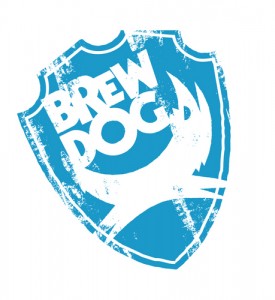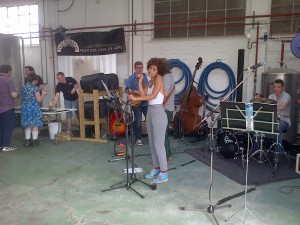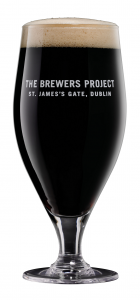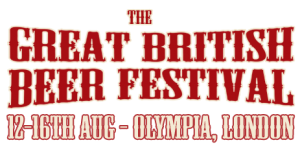There is a lot more to beer in southeast London than Bermondsey nowadays. Team Intoxicated and Kev decided that we should do the research so you don’t have to. It’s the first beerwalk©* that we have written up.
* Beerwalk is not a dance by a posthumous, cosmetically challenged singer songwriter, it’s exactly what is implied, an unsponsored walk involving beer.
Things were running late so regrettably we had to miss Orbit Beers and assembled at Brick Brewery close by Peckham Rye station. Well knock me down with a table beer, we could have been in Hoxton or Bermondsey. A cool little courtyard outside the railway  arch where they brew, natch, complete with pulled pork vendor. Due to a late arrival (well, me actually) most beers were tried. This brewery is well worth a visit because of the ‘taproom exclusives’ and quality-wise all up to scratch. The raspberry wheat was right up there. My reference for this style is Little Beer Corporation’s Little Rosy, beautifully dry and tart, one of the very best aperitif beers imho. Well Brick’s version is slightly sweeter (bad) but is paler and has far more banana-y wheat beer flavours (good). Kiwi Steam is also an easily approachable beer in an uncommon style.
arch where they brew, natch, complete with pulled pork vendor. Due to a late arrival (well, me actually) most beers were tried. This brewery is well worth a visit because of the ‘taproom exclusives’ and quality-wise all up to scratch. The raspberry wheat was right up there. My reference for this style is Little Beer Corporation’s Little Rosy, beautifully dry and tart, one of the very best aperitif beers imho. Well Brick’s version is slightly sweeter (bad) but is paler and has far more banana-y wheat beer flavours (good). Kiwi Steam is also an easily approachable beer in an uncommon style.
We could have walked to East Dulwich, but we didn’t. There’s a nice quarter mile stretch that includes East Dulwich Tavern, The Flying Pig and Hop, Burns & Black. The EDT as it’s called is an Antic pub, a proper pub unlike some of their other ventures (that’s for another time, but try going to The Job Centre in Deptford for an alternative experience). Situated in a really buzzy area at the top of Lordship Lane this is really a place to sit with the Saturday papers and have a pint of good local ale (think Gipsy Hill, Volden or Clarkshaws). Nothing exciting but good, solid stuff and well tended but maybe they could rotate a bit more. If you’re getting peckish by now then toddle on to The 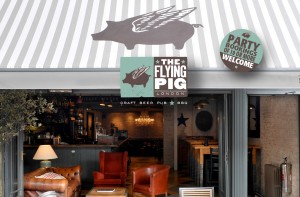 Flying Pig, one of my favourite pubs in London. The beer range here is always interesting, not just the same as other craft locals. My guess is that they don’t buy solely on price or trendiness or availability. (It’s always easy to see when the latest, say, Lagunitas shipments arrive on these shores – however good the beer is – it floods the market temporarily.) They are independent, the food looks great, seating has something for everyone, Simone and Justine are lovely (all the staff actually) but above all it is unpretentious craft. Real ale and craft are equally well represented. Now it’s time to up the trendiness factor, in the same parade is Hop, Burns & Black only opened this year. The fact that Jen, one half of the ownership, comes from Nelson gives the place instant hop cred. Apart from a great selection of beer – think locals from SE London, trendy beers and NZ beers – they also have a growler filling machine with four beers on keg. And it gets better, there is some seating outside. There’s more, the ‘Burns’ refers to a great range of hot sauces and the ‘Black’ to a couple of bins of vinyl. This is a great place, my only criticism is that it’s a tad too hip for an old fogey like me.
Flying Pig, one of my favourite pubs in London. The beer range here is always interesting, not just the same as other craft locals. My guess is that they don’t buy solely on price or trendiness or availability. (It’s always easy to see when the latest, say, Lagunitas shipments arrive on these shores – however good the beer is – it floods the market temporarily.) They are independent, the food looks great, seating has something for everyone, Simone and Justine are lovely (all the staff actually) but above all it is unpretentious craft. Real ale and craft are equally well represented. Now it’s time to up the trendiness factor, in the same parade is Hop, Burns & Black only opened this year. The fact that Jen, one half of the ownership, comes from Nelson gives the place instant hop cred. Apart from a great selection of beer – think locals from SE London, trendy beers and NZ beers – they also have a growler filling machine with four beers on keg. And it gets better, there is some seating outside. There’s more, the ‘Burns’ refers to a great range of hot sauces and the ‘Black’ to a couple of bins of vinyl. This is a great place, my only criticism is that it’s a tad too hip for an old fogey like me.
I started off my sales career repping in SE London and it was my manor. Nunhead was one of those vague areas on the other side of the Rye with nothing memorable, less than 10 minutes walk from HB&B. Now it’s a lovely little neighbourhood and for the beer enthusiast there is the Old Nun’s Head ( another addition to the Laine’s London portfolio but not brewing on site yet), Bambuni, a great deli with a good craft selection but we chose the newest addition, The Beer Shop. A modern micropub, unlike some others I’ve

Bijou but airy
been to. Micropubs, in my experience so far, often have six identical session bitters bought solely on price in a converted shop with little natural light, but it doesn’t have to be like that. This is very small but it is airy and light. It has a keg line. It has ‘craft’ scotch eggs and pork pies, not only are they craft they are bloomin’ tasty too. This would be a great place to have within walking distance.
Still thirsty, where to now? The Ivy House (community owned, good session selection, cask and keg) is a fifteen minute walk south, to the southeast there is Brockley Brewery (nice but ordinary?) or to the southwest Herne Hill has Head in a Hat (interesting but depends what the pub has on) at the Florence and Canopy (needs further investigation).
So we headed north. A ten minute walk took us to Peckham Beer Rebellion part of the Late Knights Brewery group. I am no interior designer and I don’t know if it’s the Late Knights guys or the fact that this is southeast London but, imho naturally, they only pull off the first half of shabby chic. Beer is variable, this outlet has more keg lines than some others and that’s the direction to look. Late Knights themselves tend to stick to themes on a cask ale.
It’s not like me but prior research had discovered a relatively new (aren’t they all) brewery operating out of a pub further down Queen’s Road. Now I have been in some weird pubs in my time, the Montague Arms, home of the Monkeychews brewery is right
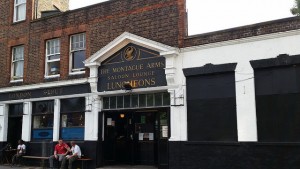
Home of the Monkeychews Brewery
up there. I have passed this pub many times in the car, it is black. Inside it is just very dark. Peering through the gloom it is actually quite comfortable to the left, nice chairs, ephemera, taxidermy and tables with globes in the middle. To the right a stage (has been a nearly famous music venue in the past) and what appeared to be a jumble sale? We didn’t like to ask. There were two Monkeychews beers on cask. Kev, who had consistently chosen the dud all day, had the one that was definitely off, it was swiftly replaced and removed from sale. Ours was almost off, it would be unfair to review it. My only complaint is that they shouldn’t have served it, I’m sure someone can make ok-ish beer there but suspect they don’t have the turnover to sell it.
So a slightly odd experience to end an interesting day walking and drinking in the newly vibrant heart of southeast London. Well it wasn’t quite the end, that was in a BYO Vietnamese restaurant eating frogs legs and pigs ears swilled down with Guinness Foreign Extra – but that’s another story.
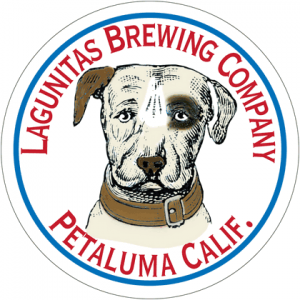 Growing pains. There’s a lot of it about in the craft beer industry. And that’s only the drinkers.
Growing pains. There’s a lot of it about in the craft beer industry. And that’s only the drinkers.




